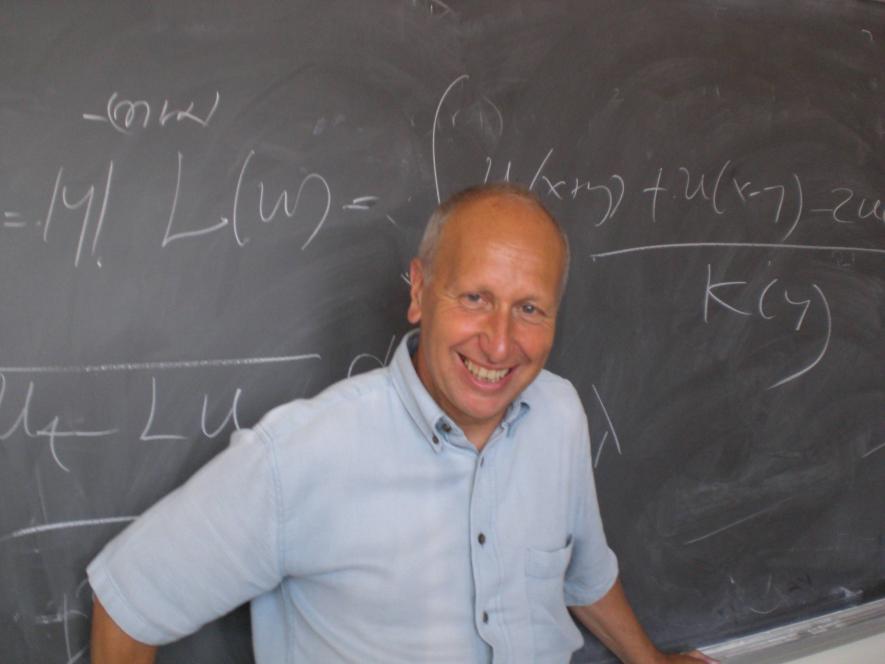Luis Cafarelli May Have a Mathematical Answer to How Ice Cubes Melt in the Juice Glass

Luis Cafarelli. Image Courtesy: Twitter/@royalsociety
Put some cubes of ice in a glass of juice or water or whiskey or anything you wish to; it will eventually melt. It is that simple, but scientists and mathematicians may take a hundred years to come out with an explanation about one of the commonest things people do in their daily lives. How the ice cube melts and what happens in the process and how to express the entire scenario in mathematical expressions are the questions that have intrigued scientists for years.
Luis Caffarelli, a gem of a mathematician of Latin American origin has solutions to some complicated mathematical equations that can nearly explain the melting problem. Luis Caffarelli has won the Abel Prize 2023 for his outstanding contribution to the field of mathematics which can provide some solutions to some unsolved fluid dynamics problems. Currently, a professor of mathematics at the University of Texas at Austin, Caffarelli happens to be the first Latin American mathematician to have won the Abel prize, one of the top international awards in mathematics and is often considered as the ‘Maths Nobel’.
The Abel Prize website recognising Caffarelli’s work and conferring the award to him says, “Luis A. Caffarelli awarded the 2023 Abel Prize for his ‘seminal contributions to regularity theory for nonlinear partial differential equations including free-boundary problems and the Monge–Ampère equation.” The Abel Prize has been awarded by the Norwegian Academy of Science and Letters since 2002.
Jay Hartzell, the president of the University of Texas at Austin, in his words of accolades for Caffarelli, said in a statement, “For more than a quarter century here at UT, Luis Caffarelli has introduced ingenious new techniques that show brilliant geometrical insight. I can’t think of a worthier selection for the highest honour in mathematics. Changing the world starts with understanding the world, and Luis has helped to advance humanity’s understanding of some of the most formidable problems in all of mathematics. His academic family tree is part of his impact and story, too, as he has mentored dozens of stellar mathematical minds.”
Caffarelli worked with a type of mathematical equation known as Partial Differential Equations (PDE). The PDEs establish a relation between some physical quantities like velocity or pressure with the rate at which these change. The PDEs can be written down simply, but finding an exact solution is extremely difficult. Finding solutions for many of the PDEs remains almost impossible. The challenge is to get solutions as near as possible to describe some physical phenomena. PDEs used in fluid dynamics are especially difficult to come out with some solutions with which real-life phenomena like free-flowing water turning dangerously furious, melting of ice etc. can be explained. Caffarelli’s contributions come in this regard—in finding solutions that are near to explaining the physical phenomena.
Now coming to Caffarelli’s significant contributions to the field of PDEs, his handling of the regularity theory and the free-boundary problems are the most celebrated ones. We will come to the explanation of the regularity theory and the boundary problems, but before let us see some of the celebrated works of Caffarelli. In his breakthrough paper published in 1977, Caffarelli showed the existence of regularity in the case of melting ice. Here he showed that the ice surface remains mostly smooth while turning into water. After over four decades of Caffarelli’s paper, the results were refined by Alessio Figalli, who was a field medal winner. The other widely talked about work of Caffarelli is the one he did combined with Robert Kohn and Luis Nirenberg, another Abel laureate in 2015. In that paper Cafferelli, Kohn and Nirenberg addressed the regularity of motion of fluids.
Mathematicians use varieties of mathematical tools in explaining physical phenomena. A simple example is the speedometer of a car, which shows at what speed a car moves. The mathematics involved in calculating the speed is to find out what distance the car travels in a certain time interval. It is not so difficult. But what, if we ask about the flow of blood through our veins or water crashing at the shore during a tsunami? What could be the mathematical formulations explaining this type of phenomenon? Caffarelli was intrigued by the mathematics involved in the flow of fluids.
In the case of fluid flow let’s again take two examples—one is water in a glass which can be stirred more easily than the oil in the same glass. Here the stickiness (or viscosity) matters; the stickier a fluid, the harder it is to stir. The second example is squeezing the ketchup bottle. As the ketchup is non-compressible (meaning the fluid is not compressed in pressure) it moves out faster from the bottle. But remember, sometimes the ketchup comes out of the bottle so rapidly that it spills over.
Viscosity and pressure had been known as important parameters in describing fluid flow, but it was in the 19th century that these parameters were put in mathematical equations to describe fluid behaviour. And the equation that we have is one of the famous PDEs known as the Navier-Stokes equation. These equations have become so important that they are used in building aeroplanes. Finding an exact solution to such equations is nearly impossible, but sophisticated computing techniques bring approximate ones that are so near to reality that can be proven useful for so many practical applications.
In such equations regularity implies smoothness, meaning that the equations don’t have breaks in between or don’t run to infinity in the entire time interval they are calculated for. On the other hand, singularities in such equations imply the equations blow into infinity at any point. In the 1982 paper, Caffarelli with his co-authors proved that singularities or regions where the equations blow into infinity if they exist would be exceedingly small.
In a talk at the Clay Institute of Mathematics, in 2001, Caffarelli explained it, “So if singularities exist, they form a very minimal set. They are physically sort of irrelevant because you will never see them, they will not have any effect.” (for the detailed article you can visit here). This means even if singularities exist a fluid will appear as flowing regularly. These are the best-known partial results of the Navier-Stokes equations now.
The other important contribution is the free boundary problem that Caffarelli dealt with. An example of it is again the ice-melting phenomenon. Ice and water both are made up of the same molecules but exist in different forms. There exists a boundary or if we may say, an interface, between ice and water. When ice melts, the boundary shifts. As Caffarelli’s equations confirmed, “The surface of the ice theoretically becomes entirely covered in spiky bumps, called singularities, rarely observed in the real world but small, short-lived and uncommon,” wrote UT News of the University of Texas at Austin.
Get the latest reports & analysis with people's perspective on Protests, movements & deep analytical videos, discussions of the current affairs in your Telegram app. Subscribe to NewsClick's Telegram channel & get Real-Time updates on stories, as they get published on our website.















